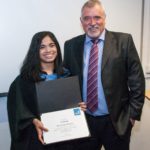I have recently completed my MSC in Prosthetics and Orthotics at the University of Strathclyde which would not have been possible without the support and generosity of OETT, who provided 67% of the tuition fees, enabling me to carry out this period of study.
My thesis focused on KAFOs as well as patient interaction, where I considered issues surrounding communication strategies. This gave me the opportunity to research patient information leaflets with particular reference to KAFO’s which has been extremely beneficial to both my clinical and professional practice. I would like to take this opportunity to thank OETT for their very generous assistance, for which I am very grateful.
